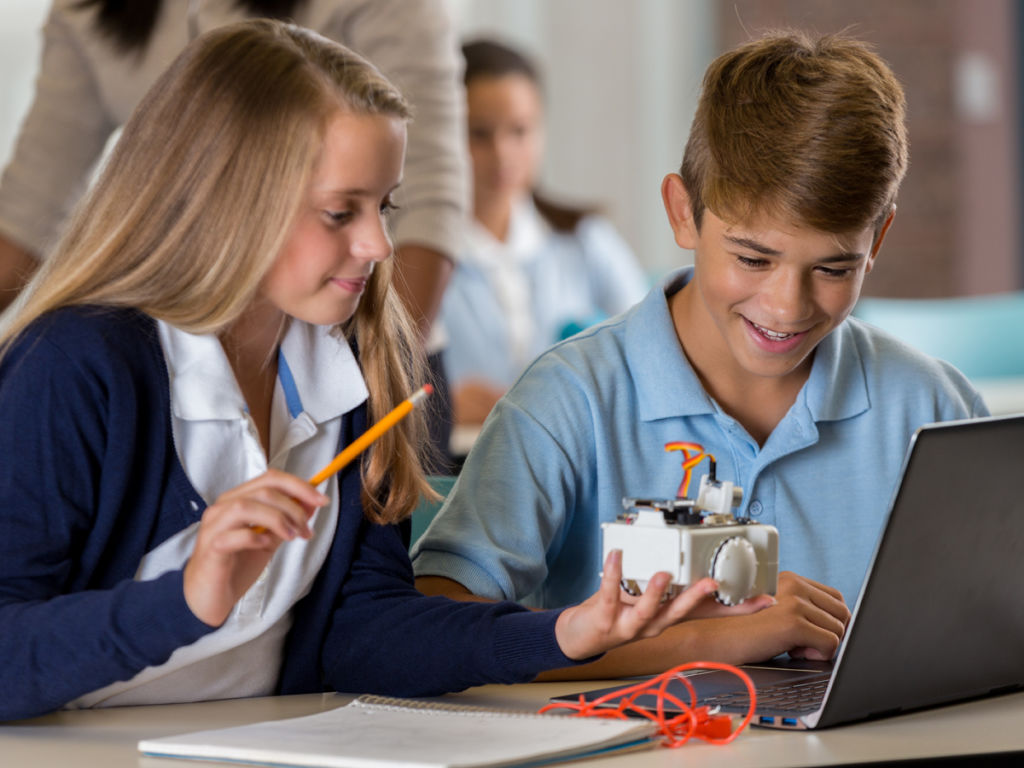Updating the digital curriculum in Melbourne schools

Technology in classrooms is nothing new, but the exponential growth of digital devices – especially in the past decade – has made it a much more common part of the learning experience in Australia.
As technology has progressed in leaps and bounds, the curriculum, schools and teachers have all had to keep pace.
Joanne Blannin, a digital learning leader with the University of Melbourne’s graduate school of education, says Australian students in years 2-10 have a new digital technology curriculum to work from.
“We used to have the ICT (information communication technology) curriculum that, in the past, if you were in year 3 you could put together a PowerPoint presentation about your favourite insect and you would have achieved a successful outcome,” she says. “The difference now is students are learning about how digital systems like how a Wi-Fi router works, and how it connects to the internet.”
Students also use apps to – for example – track their favourite insects, learn more about them and share the information online with classmates.
Joanne says the curriculum aims to prepare students for the future workforce – for jobs that will likely involve technologies and require the types of skills that are being taught alongside how technology is used. They include problem solving; how to think critically, creatively and entrepreneurially; and collaborating with other students online.
Teachers need to study, too

Teachers are also having to study to keep up with the latest ways to use technology.
“Some schools are already working with the new curriculum easily,” Joanne says. “For others, this is brand new, with new outcomes that [many] teachers were never taught. It was not a part of their teacher education.”
Technology can be part of any STEM (science, technology, engineering and mathematics) class, but Joanne says schools are also integrating technology throughout their curriculums.
“Schools can connect it to other parts of the curriculum,” she says. “If they’re learning English or history or geography, then they can connect with the idea of digital systems.”
As well as devices such as laptops and smartphones, coding is becoming part of the school vernacular.
In Melbourne, some schools have started coding clubs in recent years. Many such clubs run outside normal school hours. “In the past couple of years I’ve worked with about 600 schools across Australia – remote, private and Catholic,” Joanne says. “There are pockets of excellence … where the school and teachers are really ahead of the game.”
Does technology help learning?
A range of studies has shown the effectiveness, or lack thereof, of learning when technology is used in classrooms. Joanne says its benefit for students comes down to how individual teachers use technology as part of lessons.
“A laptop is an inanimate object – it is what the teacher and the student do with that object that supports student learning or not,” she says. “For a teacher who has a real ability to teach and exciting ways to teach, [devices] seem to work really well because they’re just another tool in the teaching toolkit.
“If you are a very traditional type of teacher, who relies mainly on speaking at the students rather than working with the students, you might find teaching with technology more challenging.
“Blaming the technology [for not providing effective learning] just doesn’t seem very useful to me because the effectiveness of it really comes down to the user,” she says.
Beyond making classes more immersive and fun, technology also makes learning more connected across the world. That means it is more purposeful, Joanne says. Innovations include websites such as Skype in the Classroom, which has a list of scientists or experts from all around the world that teachers can ask questions or book to talk to classes.
“I had a scientist in Antarctica talk to a class on Skype and he turned the camera around to show the students the penguins out of the window,” she says.
Another time, a scientist in Arizona talked to a class in Darwin about the desert.
“Those things offer so much more than a textbook and an atlas,” Joanne says. “It’s the kind of learning they’re going to need when they leave school and enter the workforce.”
The future of schools
The future of eduction is already here, experts say. Joanne says a lot of schools that got money under the Building the Education Revolution scheme in the past 10 years built open-plan classroom buildings. That followed a push towards non-traditional classrooms: rooms designed for more than a teacher at the front, speaking to students.
“We know, particularly in primary school, [traditional] is not the only way that students can work in a classroom,” Joanne says. “My doctoral research is looking at teachers who do use technology and what factors help them do that. One of the factors that’s coming out very strongly is that teachers are going to have to work far more closely together.”
She says a shared understanding of technology is necessary, because there’s no way for an individual to keep up with everything that is happening. “Teachers need to be able to say ‘I don’t know how to do this but if someone in our team does, then we can all do it’,” she says.
More collaboration is also needed between year levels and schools, as well as work to teach to students’ skill levels and understanding, rather than age groups.
“Open-plan spaces (classrooms), if they’re used well, they can really help teachers do that,” Joanne says.
We recommend
We thought you might like
States
Capital Cities
Capital Cities - Rentals
Popular Areas
Allhomes
More
- © 2025, CoStar Group Inc.







